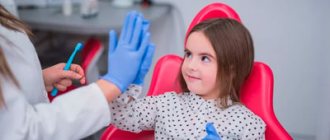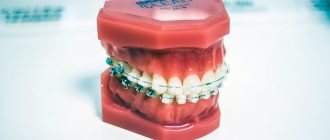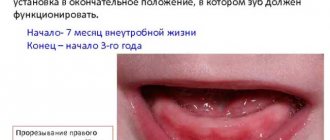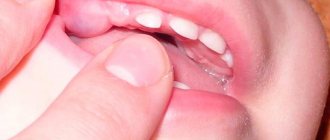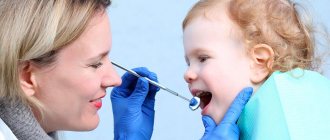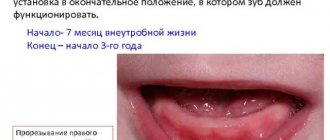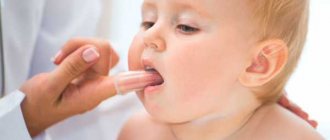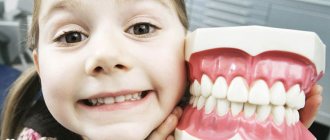A child's teeth grow in two rows
With proper development of the jaw at the right age, permanent teeth begin to erupt and put pressure on the roots of the milk units.
Under this influence, the roots dissolve - the baby tooth becomes mobile, it wobbles and then falls out. This is a normal change in bite, the algorithm of which is known to most. But in rare cases the situation develops differently:
- when the germ of a permanent tooth and the root of the milk tooth are located in parallel planes, there is no pressure on the roots, and the permanent tooth grows in close proximity to the milk tooth;
- when the permanent one erupts quickly, and the roots of the milk unit have not yet resolved, the tooth does not fall out, and the permanent one has to bend and grow at an angle;
- when a child has a supernumerary set of teeth.
Various reasons - one result: the child’s teeth grow in the second row, threatening to ruin the permanent bite.
Teething in children: modern concepts
The eruption of baby teeth in children is a routine process that no individual can avoid. This process is determined by both genetic and environmental factors. Theoretically, innervation-induced pressure in the apical part of the teeth induces the process of eruption, which requires long-term adaptation from the periodontal membrane, as well as active movement of the crown follicle, which destroys the overlying bone tissue.
For many years, discussions have continued among representatives of pediatric specialties regarding teething and its impact on the health of infants [1–3]. Therefore, it was even proposed to consider the so-called “teething syndrome in infants,” which has a corresponding reflection in the International Classification of Diseases, 10th revision - ICD-10 (code K00.7) [2]. Apparently, in the coming years it will find its place in ICD-11.
The opinion of the medical community on the issue of the use of special gels that alleviate the main symptoms that often accompany teething, which will be discussed below, seems equally ambiguous.
The appearance of teeth: just the facts
The formation of teeth occurs approximately on the 40th day of embryonic life. The eruption of primary teeth most often occurs in the second half of the first year of life, usually at the age of 6–8 months.
The order of teething in the first year of life is as follows:
- lower middle incisors;
- upper middle incisors;
- upper lateral incisors;
- lower lateral incisors.
In the latest (20th) edition of the Nelson Textbook of Pediatrics, N. Tinanoff (2016) provides the following information about baby teeth:
- lower middle incisors: first signs of calcification (SCC) - 4.5 months of intrauterine development, crown formation (FC) - 4 months, eruption (E) - 6.5 months;
- upper middle incisors: PPK - 3–4 months of intrauterine development, FC - 4 months, P - 7.5 months;
- upper lateral incisors: PPK - 4.5 months of intrauterine development, FC - 5 months, P - 8 months;
- lower lateral incisors: PPK - 4.5 months of intrauterine development, FC - 4¼ months, P - 7 months;
- lower canines: PPK - 5 months of intrauterine development, FC - 9 months, P - 16–20 months;
- upper canines: PPK - 5.5 months of intrauterine development, FC - 9 months, P - 16–20 months;
- first upper molar: PPK - 5 months of intrauterine development, FC - 6 months, P - 12–16 months;
- first lower molar: PPK - 5 months of intrauterine development, FC - 6 months, P - 12–16 months;
- second upper molar: PPK - 6 months of intrauterine development, FC - 10-12 months, P - 20-30 months;
- second lower molar: PPK - 6 months of intrauterine development, FC - 10-12 months, P - 20-30 months [1].
It is quite natural that the timing and order of teething may differ significantly from those given above (the individual characteristics of this process are often genetically determined). To a certain extent, the timing of teething depends on the gender of the child; in girls it usually occurs somewhat earlier and faster.
According to the proposal of A.F. Tour, to calculate the number of baby teeth that a child aged 6–24 months should have, it is necessary to subtract the number 4 from the number of months of life (actual calendar age) [4].
Currently, it is believed that in the process of teething, it is not so much direct perforation of the gum mucosa by crowns that occurs, but rather an increased production of certain hormones in the child’s body, which cause cell death in the gums, freeing up space for teeth.
The review work by I. Kjær (2014) outlines modern ideas about the mechanisms of the process of primary teething in children, and also presents the author’s own hypothesis, according to which the described physiological process depends on three main factors:
- free space in the path of teething;
- lift or pressure from below;
- adaptability (adaptability) of teeth in the periodental membrane [5].
In general, among the many theories and hypotheses (there are about 500 in total) explaining the mechanisms of teething, only four deserve attention: 1) growth of the tooth root; 2) increased hydrostatic pressure in the periapical zone or dental pulp; 3) reconstruction of bone tissue; 4) periodontal traction [6].
In the Russian Federation, explanations for the mechanisms of teething are usually found in the theories of John Hunter (“root” theory), G. V. Yasvoin (“rocket” theory) and A. Ya. Katz (the theory of pressure of a growing tooth on the side walls of the alveoli), as well as I. G. Lukomsky (theory of simultaneous development of tooth and alveolar bone), which readers can familiarize themselves with if they wish.
The crown follicle destroys the overlying bone tissue and thus provides the necessary space along the teething route. This process depends on the state of the ectoderm in the tooth follicle.
The root shield acts as a glandular membrane, the innervation of which creates excess pressure that forces the teeth towards the surface of the shield, periodontal membrane and pulp tissue. As a result of this pressure, the teeth rise in the direction of eruption.
Problematic teething
On the one hand, many pediatricians believe that the teething process does not cause fever or diarrhea. On the other hand, tens to hundreds of articles report hypothermia accompanying teething, bowel disorders and many other symptoms accompanying this physiological process. In general, the medical community recognizes that teething can be accompanied by pain and increased body temperature (hyperthermia) [1].
The so-called “difficult teething” (dentitio difficilis) may be accompanied by local symptoms (swelling/redness/itching of the gums), general malaise, loss of appetite, hypersalivation, rhinorrhea, restlessness and irritability, nausea, regurgitation/vomiting, sleep disturbances, increased body temperature , dyspeptic symptoms, skin rashes, delay or slowdown in weight gain, etc. [7–10].
As indicated by A.L. Zaplatnikov et al. (2018), a key role in the development of various teething symptoms belongs to pro-inflammatory cytokines (in the gingival fluid during primary teething, the concentration of interleukin-1, interleukin-2 and interleukin-8, as well as tumor necrosis factor α, increases) [2].
The presence of symptoms such as hyperthermia, sialorrhea/hypersalivation, sleep disturbances and irritability in children during the first years of life during teething is confirmed by the work of M. Memarpour et al. (2015), S. Massignan et al. (2016), and M. A. Nemezio et al. (2017), and the last two publications used tools and approaches of evidence-based medicine - a systematic review and meta-analysis [11–13].
Since it has been repeatedly demonstrated over the years that the eruption of primary teeth can be problematic and accompanied by pathological manifestations, there is no doubt about the need to treat these symptoms. For this purpose, paracetamol and ibuprofen (oral or rectal dosage forms), some systemic homeopathic remedies (Viburkol, etc.), as well as special children's gels for gums during teething can be used [14–17].
The most convenient to use are topical gels, which are widely used in many countries around the world.
Teething Gels: Possible Ingredients
Currently, about a dozen products for this purpose are simultaneously presented in the pharmacy network of the Russian Federation. If we try to symbolically classify all the currently available gels for gums during teething, then they can be conditionally classified into one of three categories:
1) synthetic gels (with analgesics/anaesthetics); 2) gels based on natural plant extracts; 3) combined gels: synthetic anesthetics combined with natural plant extracts.
The anesthetics in the described gels are most often lidocaine, benzocaine and/or choline salicylate.
Among the antiseptic ingredients of the gels are cetylpyridinium chloride and cetalkonium chloride.
Other components that may be used are polidocanol (a non-ionic detergent) and trometamol (an anti-acidemic agent); these pharmacological agents provide a predominantly local cooling effect when applied to the child's gums.
Dangerous components of teething gum gels
In 2011, the US Food and Drug Administration (FDA) called for the avoidance of any benzocaine-containing products to treat teething symptoms. This recommendation is based on the risk of developing methemoglobinemia in children under the influence of the described anesthetic. Methemoglobinemia is a rare but very serious condition that can sometimes be fatal.
EJ Ip et al. (2018) asked two hundred pharmacists working in 115 pharmacies in the San Francisco Bay Area (USA) to complete a 16-item questionnaire. The majority of respondents (63.0%) were still inclined to recommend benzocaine-containing gum gels for teething infants [18]. Pediatricians have known about the possibility of acute and chronic intoxication with salicylates contained in teething gum gels for more than forty years.
In 2014, the FDA did not recommend the use of lidocaine in teething gels for children. An overdose of lidocaine rubbed into the gums, or if a child swallows too much of it, may cause seizures, severe brain damage, or cardiovascular problems. There are also cases of accidental poisoning of children with lidocaine during its topical use, sometimes with a fatal outcome.
As it turned out, the use of teething gels is accompanied by a potential risk of developing intoxication due to the content of salicylates in them. This, in particular, is reported in the publications of GD Williams et al. (2011), as well as in the latest works of T. Nguyen et al. (2018) and K. E. Hofer et al. (2018) [19–21].
Since 2014 in the UK, the use of oral gels containing salicylates is not recommended for patients under the age of 16 years, which completely excludes such indications for their use as teething in infants. T. K. Oman et al. (2008) demonstrated a case of the development of Reye's syndrome in a 20-month-old child after using a teething gel with choline salicylate [22]. It is believed that this particular case served as the basis for the corresponding recommendations of the British Commission on Human Medicines (CHM). Although representatives of the Medicines and Healthcare Products Regulatory Agency (MHRA) are inclined to believe that the described case is more consistent not with Reye's syndrome, but with acute salicylate poisoning, the recommendation is not to use oral topical gels with salicylic salts acid is retained.
Due to the fact that all anesthetics without exception (benzocaine, lidocaine, salicylates) included in anesthetic gels can pose a danger to the health and life of children, preference should be given to those topical products that do not contain the components listed above, but natural extracts medicinal plants. A similar point of view is shared by T. V. Kazyukova et al. (2015), I. A. Khoshchevskaya (2013), M. G. Lukashevich (2016), E. I. Kleschenko et al. (2017), as well as E. A. Goreva et al. (2017) [7, 9, 10, 23, 24]. M. G. Shchegoleva writes about the preference of protective gels for gums during teething (2015) [25].
Protective gels versus anesthetic gels
One of the newest concepts in recent years is the use of gum gels during teething, which create a protective film at the site of application and do not contain sugar or parabens. Thus, quite recently S. Rosu et al. (2018) presented the results of a pilot randomized trial (open and controlled) carried out by representatives of a number of Romanian and Italian medical institutions. In the study described, a protective gel for gums was used [26].
This gel was used in 27 children (age 3–36 months) for 7 consecutive days; The FLACC system (Face, Legs, Activity, Cry and Consolability Pain Assessment Tool) was used to assess pain. The presence of teething was determined by at least three signs: local pain, swelling, erythema, hypersalivation and deep characteristics of unerupted teeth. Primary symptoms were assessed at baseline and then on days 3 and 7. In addition, the patients' parents recorded daily changes in crying, oral spasms, salivation, local tenderness, swelling and hyperemia of the gums in the charts. The comparison group consisted of 30 children of the same age, in whose treatment a standard industrial gel was used (containing lidocaine, lauromacrogol 600 and chamomile extract); The same research methods were used as in the main observation group [26].
The results of the study made it possible to demonstrate in children of the main group a significant reduction in the severity of pain and swelling of the gums (from the first to the seventh day, p = 0.034), hyperemia (from the first to the third day - p = 0.045, and from the first to the seventh day - p < 0.001 ), which was confirmed by the records of the patients' parents. When assessing the sum of indicators using the FLACC system, the differences between the observation groups were p < 0.005 (in favor of the main group) [26].
As one of the new representatives of protective gels based on natural ingredients available in Russia, one should consider Dentinale® natura, which is an over-the-counter product. Children's gel for gums during teething Dentinal Nature contains the following herbal ingredients:
- natural extract of boswellia/frankincense tree resin (Boswellia serrata);
- natural extract of chamomile (Chamomilla recutita);
- natural extract of aloe/agagae leaf juice (Aloe barbadensis);
- natural extract of saffron (Crocus sativus);
- Sweet orange peel oil (Citrus aurantium dulcis).
All of these components have a pronounced anti-inflammatory, antiseptic and regenerating effect when the described gel is applied to the gums [27]. Boswellia, in addition to the properties described above, also has analgesic properties [28].
Dentinale nature gel, when applied to the gums, forms a protective film, thereby reducing hypersensitivity, inflammation and irritation of the gums (without the use of analgesics). Additional positive characteristics of the product are the absence of sugar and parabens (esters of parabenzoic acid) in its composition.
Apparently, it should be considered that protective gels based on natural plant extracts (Dentinale Natura, etc.) are not just a full-fledged alternative to products for a similar purpose containing lidocaine, benzocaine and/or salicylates, but are significantly superior to them. Protective gels based on natural plant extracts have better tolerability and, most importantly, a better safety profile, and there are no restrictions on their use.
Literature
- Nelson textbook of pediatrics. Kliegman RM, Stanton BF, St Geme III JW et al., eds. 20th ed. Philadelphia. Elsevier, 2016. 3474.
- Zaplatnikov A.L., Kasyanova A.N., Maykova I.D. Teething syndrome in infants: a new look at an old problem // RMJ. 2018; 5 (II): 68–71.
- Sood S., Sood M. Teething: myths and facts // J. Clin. Pediatr. Dent. 2010; 35(1):9–13.
- Tur A. F. Propaedeutics of childhood diseases. 5th edition. L.: Medicine, 1967. 492 p.
- Kjær I. Mechanism of human tooth eruption: review article including a new theory for future studies on the eruption process // Scientifica (Cairo). 2014; 2014: 341905.
- Pediatric therapeutic dentistry. National leadership / Ed. Leontyeva V.K., Kiselnikova L.P.M.: GEOTAR-Media, 2010. 896 p.
- Kazyukova T.V., Radtsig E.Yu., Pankratov I.V. Symptoms of the eruption of primary teeth and possible ways of pharmacological action // RMJ. 2015; 22: 1342–1344.
- Zakharova I. N., Kholodova I. N., Dmitrieva Yu. A., Morozova N. V., Mozzhukhina N. V., Kholodov D. I. Can the physiological process of teething be pathological? // Medical advice. 2016; 01:31–35.
- Lukashevich M. G. The place of drugs based on plant extracts in alleviating the symptoms of painful teething // RMZh. 2016; 18: 1232–1234.
- Kleshchenko E. I., Zhdanova I. A., Lukisha A. N., Krakovets I. V., Smychkova E. V., Kartavtseva A. V. Symptoms of teething in infants: condition or disease? // Kuban Scientific Medical Bulletin. 2017; 24 (4): 78–81.
- Memarpour M., Soltanimehr E., Eskandarian T. Signs and symptoms associated with primary tooth eruption: a clinical trial of nonpharmacological remedies // BMC Oral Health. 2015; 15:88.
- Massignan C., Cardoso M., Porporatti AL, Aydinoz S., Canto Gde L., Mezzomo LA, Bolan M. Signs and symptoms of primary tooth eruption: a meta-analysis // Pediatrics. 2016; 137(3):e20153501.
- Nemezio M.A., de Oliveira K. Mh., Romualdo PC, Queiroz A.M., Paula-E-Silva F. Wg., Silva R. Ab., Küchler E.C. Association between fever and primary tooth eruption: a systematic review and meta-analysis / /Int. J. Clin. Pediatr. Dent. 2017; 10 (3): 293–298.
- Shelkovsky V.I., Studenikin V.M., Pak L.A., Tursunkhuzhaeva S.Sh. Nonsteroidal anti-inflammatory drugs in pediatric practice // Attending Physician. 2011; 11:82–84.
- Studenikin V.M., Tursunkhuzhaeva S.Sh., Shelkovsky V.I. Ibuprofen and its use in pediatrics and child neurology // Issues. pract. pediatrics. 2010; 5 (5): 140–144.
- Studenikin V.M., Akoev Yu.S. Antipyretics/analgesics in modern pediatrics: allopathy and homeopathy // Attending Physician. 2016; 6:7–11.
- Taneja D., Khurana A., Vichitra A., Sarkar S., Gupta AK, Mittal R., Bawaskar R., Sahoo AR, Prusty U., Singh S., Sharma M., Pant R., Singh U., Upadhyay AK, Sehegal S., Patnaik S., Nath T., Manchanda RK An assessment of a public health initiative of homeopathy for primary teething // Homeopathy. 2018; Nov. 20. DOI: 10.1055/s-0038–1673650. .
- Ip EJ, Patel PB, Chi JJ, Shah-Manek B., Lau B. What are pharmacists recommending for infant teething treatment? // J. Am. Pharm. Assoc. 2018; 58(1):79–83.
- Williams GD, Kirk EP, Wilson CJ, Meadows CA, Chan BS Salicylate intoxication from teething gel in infancy // Med. J. Aust. 2011; 194(3):146–148.
- Nguyen T., Cranswick N., Rosenbaum J., Gelbart B., Tosif S. // J. Paediatr. Child Health. 2018; 54(5):576–578.
- Hofer KE, Kaegi S., Weiler S. The acute toxicity profile of a teething gel containing salicylamide in toddlers: an observational poisons center-based study // Clin. Toxicol. (Phila). 2018; 16:1–2.
- Oman TK, Stewart MC, Burns A., Lang TF Topical choline salycilates implicated in Reye's syndrome // BMJ. 2008; 336:1376.
- Khoshchevskaya I. A. Teething: how to help a child? // Medical advice. 2013; 2:36–40.
- Goreva E. A., Petrenko A. V., Babailov M. S. The use of herbal preparations for teething syndrome in children // Health and education in the XXI century. 2017; 19 (10): 71–73.
- Shchegoleva M. G. Comparative assessment of means that facilitate teething // Medicine today and tomorrow. 2015; 2 (67): 142–146.
- Rosu S., Barattini DF, Murina F., Gafencu M. New medical device coating mouth gel for temporary relief of teething symptoms: a pilot randomized, open-label, controlled study // Minerva Pediatr. 2018; Oct. 4. DOI: 10.23736/S0026–4946.18.05360–4. [Epub ahead of print].
- Nutrients, conditional nutrients and antinutrients in neurodietology of childhood (handbook) / Ed. Studenikina V. M. M.: Dynasty, 2016. 184 p.
- Prabhavathi K., Chandra US, Soanker R., Rani PU A randomized, double blind, placebo controlled, cross over study to evaluate the analgesic activity of Boswellia serrata in healthy volunteers using mechanical pain model // Indian J Pharmacol. 2014; 46(5):475–479.
V. M. Studenikin , Doctor of Medical Sciences, Professor, Academician of RAE and MAE
OOO NPSMC "Dream Clinic", Moscow
Contact Information
Teething in children: modern concepts / V. M. Studenikin For citation: Attending physician No. 1/2019; Page numbers in the issue: 7-11 Tags: baby teeth, fever, hypersalivation, itchy gums
What to do when teeth grow in two rows
With “shark” jaws, the most reasonable solution seems to be the removal of excess milk units. And they did this for a long time. The result of hasty decisions showed that hasty removal of primary incisors and fangs leads to the opposite result and the formation of a malocclusion. After this, pediatric dental surgeons began to see children only as prescribed by the orthodontist - after professional consultation with a specialist.
An orthodontist is the first doctor you should go to when teeth grow in two rows. The doctor will assess the prospects for the formation of the dentition, send you for an x-ray to accurately determine the rudiments of permanent teeth and make the right decision. And this will not always be immediate removal of a baby tooth!
Based on the results of the diagnosis and examination, the orthodontist can advise:
- increase the amount of solid food in the child’s menu - provide the missing pressure on the baby tooth, causing it to loosen and fall out;
- wait for the natural change of teeth so that the permanent unit moves into its intended place under the influence of other teeth and under the pressure of the tongue muscles;
- remove primary incisors and canines to forcefully free up space.
The latter purpose is typical for parallel growing teeth and firmly standing primary units, since this is the only case when there are no natural prerequisites for root resorption and normal bite changes.
Why is the sequence broken?
The dentition is formed individually. This is influenced by many factors, for example, genetic predisposition. Therefore, the baby receives from the parents:
- Timing and order of birth of masticatory organs.
- Quality of enamel and strength of crowns.
If mom or dad had an incorrect pattern for the teething of units, the baby may also have them out of order. Non-standard appearance of units and discrepancies in terms are normal if:
- The baby tooth begins to emerge a month earlier or later;
- The order of appearance of the incisors is disrupted, that is, the upper one is born first, and then the lower one;
Remember that there is no method of influencing the time and speed of eruption in medicine. There are other reasons when a baby’s teeth grow out of order.
- Features of the pregnancy process, complications and illnesses of the mother: influenza, infectious diseases. Bad habits of a woman in labor have a negative impact.
- Infectious diseases that the child suffered: scarlet fever or measles.
- Lack of breastfeeding weakens the work of the newborn's facial muscles. His lower jaw does not develop enough, since sucking from a bottle is done with his lips. This provokes the initial appearance of incisors on the upper jaw.
- An ordinary pacifier if abused.
- Changes in climatic conditions.
- Parents of different nationalities.
These processes cannot be treated. It is important that all chewing organs come out so as not to miss the child’s gum inflammation. Medicine is not aware of cases where children are left without incisors and molars due to unbalanced eruption of units. They will grow up, you need to wait and take care of the little one.
Causes and consequences of dental pathology
Abnormal two-row growth is possible for many reasons:
- heredity;
- chronic colds and decreased immunity;
- unhealthy diet with a predominance of soft foods and purees;
- lack of vitamins and useful elements;
- premature removal of milk units;
- disturbance in the location of tooth germs.
With timely treatment, the orthodontist will easily straighten the bite and place each tooth in its proper place. If you delay visiting a doctor, the consequences can be serious:
- malocclusion;
- problems with hygiene and the development of caries;
- facial deformation due to jaw imbalances;
- ugly smile.
A sign of a potential shark jaw is the absence of gaps between the teeth in a 4-6 year old child. Insufficient space is the first prerequisite for the appearance of a second row of teeth in children and a signal for an attentive parent.
It is easy to see an incorrectly growing tooth, especially in the lower jaw. During the period of change in bite, dentists recommend monitoring the process - periodically conducting home or professional examinations and listening carefully to the baby. Complaints of discomfort in the mouth, inconvenience of chewing and pain indicate the need to visit a dentist to assess the condition of the oral cavity.
What to do if your teeth are cutting incorrectly
First of all, don't panic. When your toddler's teeth are cut out of order, balance his diet. After 5-6 months, a child, in addition to mother's milk, should receive complementary foods. It is important to measure the time of wakefulness and sleep. It is necessary to take the baby to the pediatrician for examination in a timely manner. If he prescribes a complex of vitamins, you must take them. Self-selection of medications can harm the child’s health.
The baby should be examined by a pediatric orthodontist. If there are no developmental pathologies, there is no need to worry. An objective assessment of the condition is the main criterion of health. If units emerge out of order, doctors advise observation and not skipping preventive examinations. When a one-year-old baby’s chewing organs do not grow, this is a reason for examination. This situation indicates a disturbance in metabolic processes. Violations in the order of birth of teeth should be closely monitored and reacted only if necessary.
Growth of baby teeth in the second row
Hyperdontia (supernumerary tooth) in the picture
The rudiments of baby teeth are formed in the womb, so their pathologies are associated with a lack of space in the jaw for all the incisors. Among the most common reasons that provoke improper growth of baby teeth:
- unbalanced diet of a woman during pregnancy;
- deficiency of calcium, fluorine (essential microelements necessary for the formation of bone tissue);
- lack of solid food;
- uncontrolled use of a pacifier;
- heredity.
It also happens that molars and molars come in second row. This phenomenon is explained by the following factors:
- underdevelopment of the jaw, due to which there is not enough space to accommodate a full set of teeth;
- hyperdontia (superset of teeth).
Which teeth appear first?
If the timing of the appearance of baby teeth in all children is quite individual, then the order of eruption is always the same (except in rare cases). The first to appear in the dentition are the incisors - the frontal teeth, located in the center of the jaw arch and having an elongated shape with a sharp surface intended for biting off food. The lower incisors usually appear first - they are slightly smaller than the teeth located in the upper dentition, but perform the same functions and have the same structure.
First central incisors - photo
Table No. 1. Scheme of eruption of incisors in a baby.
| Teeth position | Appearance date |
| Lower anterior incisors | 4-8 months |
| Upper frontal incisors | 6-9 months |
| Lateral lower incisors | 9-12 months |
| Upper lateral incisors | 10-16 months |
Note! During the first year of life, a child should normally erupt 8 teeth - 4 incisors on each jaw. It is possible that a child at this age has 7 teeth or even 2-4 teeth. Such a clinical picture can be considered normal if the child does not have chronic diseases of the endocrine system and other pathologies characterized by slowing or disruption of metabolic processes. If a one-year-old child has missing teeth, you should undergo an examination - this may be a symptom of rickets or a manifestation of adentia.
Baby is cutting teeth
Preventive measures
Solid foods will help the process of changing baby teeth to molars.
You can reduce the risk of dental anomalies (growth in two rows) by following the following recommendations:
- If you identify any problem in the oral cavity (including if a tooth has come out crooked or second row), you need to contact your dentist in a timely manner.
- The child's diet should include solid foods. This will help baby teeth fall out on time.
- If there are no upper respiratory tract disorders, then it is necessary to teach children to breathe through their nose. If nasopharyngeal diseases are detected, it is recommended not to delay treatment.
- From an early age, the baby should be involved in hygiene procedures to avoid the development of caries.
- It is necessary to wean the baby from putting everything in his mouth, especially sucking a finger or any objects.
- Do not let the child touch the growing incisor with his hands or constantly lick it with his tongue.
No matter how serious the problem may seem, it can be corrected quite easily if you contact a specialist in a timely manner.
Complications during the eruption of baby teeth
The process of teething is a huge burden on a child’s body, so it is associated with some unpleasant sensations. Decreased appetite, insomnia, crying and fever are normal. Most likely, the child will be capricious, scream, and try to chew various objects to relieve the itching of the gums, and parents should be mentally prepared for this. However, a temperature above 38 degrees that persists for a long time is an alarming symptom of teething in children; in such circumstances, it is better to consult a specialist.
Sometimes a purple spot may appear on the baby's gum - a teething hematoma. It indicates that the tooth has already begun to erupt through the mucous membrane, but cannot pass further for a number of reasons: infection, improper development of teeth or lack of free space. This is associated with difficulty in teething. Later, a small formation may be seen at the site where the tooth should appear - a dentition cyst. Under no circumstances should you self-medicate; this will lead to improper eruption of baby teeth, infectious diseases and tissue damage. It is necessary to consult a doctor who will quickly and painlessly help the tooth erupt.

